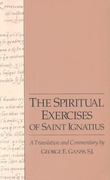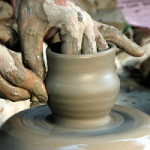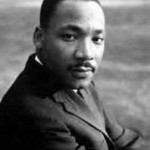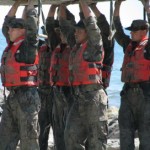Today I finally received a copy of The Spiritual Exercises of Saint Ignatius from Paperback Swap. I have been intrigued by the Jesuit Order probably since I first saw a Jesuit missionary portrayed in a movie, and could not be sure if he was a good guy or bad guy. I chose to do a brief study (which I have included below) of the Jesuits and Ignatius for research in the Global Christian History course at Wesley Seminary.

I plan to go through the Exercises as part of my personal spiritual formation. I have only had a chance to look at the work briefly at this point, but it seems that the cycle covers one month and should begin on a Sunday, so I plan to begin on Sunday, July 1 June 17th. This will give me a little time to read the notes and commentary to get an idea of what I might be getting myself into. I plan to blog about this experience at least once a week. I hope to grow spiritually, gain insight into a Roman Catholic tradition, and hopefully glean some some things that I can teach others in spiritual formation.
This is a continuing series as I go through The Spiritual Exercises of Saint Ignatius.
MDIV580 Jesuits
The Society of Jesus, the Jesuits, has an interesting and sometimes controversial history, full of lessons for Christians today. The society’s founder, training, and endeavors have allowed the members to build a religious order, that along with the Benedictines, Dominicans, and Franciscans, have endured into the modern era. In literature and movies, Jesuits dressed in black robes often fill the role of the intelligent antagonist, one whom we can never be sure of their motives or intentions. From these sources, one can never be certain if the historical Jesuits were actually priests, monks, missionaries, soldiers, educators, diplomats, or spies. Perhaps, what they were and are depends upon one’s perspective.
Loyola
Born in 1491, Iñigo Lopez de Loyola probably never dreamed of founding a religious order. Born into a noble Spanish family, Loyola served as a soldier and general, but this course of life was changed on May 20, 1521, when his leg was shattered by cannon fire. Because of this injury being a military leader may or may not have still been an option, as he would walk with a limp for the rest of his life, but he took this experience as a sign that perhaps he should be doing something else.
As his body healed, Loyola read devotional books, such as the Life of Christ by Carthusian Ludolph and The Golden Legend, books which describe the lives of Jesus and the saints in a mythical manner. According to David Mitchell (1981), it was through these readings that Loyola began to see Jesus as the “Liege Lord,” who wanted his followers to be “holy knights,” and where he found the “rough basis for the Spiritual Exercises.” Loyola’s mix of military experience and intense religious devotion was developing a model for the future Society of Jesus.
The Spiritual Exercises
Loyola eventually set out on a pilgrimage to the Holy Land for two years where he was in contact with Benedictines, Dominicans, and Franciscans. Here he worked on the Spiritual Exercises. He tried to live as a poor ascetic, but his nobility showed through. During this time he realized he needed to improve his education, including learning Latin, so he returned from Jerusalem. He studied in Barcelona, Alcala, and Paris, picking up disciples, by means of the Spiritual Exercises, his noble birth, and enamor of having made a pilgrimage to the Holy Land, along the way.
Ignatius Loyola, as he was now known, was wise in his use of the Spiritual Exercises. Loyola was imprisoned while the text of the Exercises was examined for heresy, and found to be orthodox. This method of spiritual formation could be practices by either men or women. Loyola also created demand for the text by not having a great amount printed and not making it available for sell. A copy of the Exercises could only be given. Even today, I could not find a complete text online, but according to Mitchell (1981) the text was influenced by devotion moderna and Thomas à Kempis’ Imitation of Christ. Jesuit training now takes as long, or longer, than training to become a medical doctor.
The Jesuit Order
The order was approved by Pope Paul III in 1540 (Cairns, 1996), and was founded for education, to fight heresy, and as a missionary society. The Jesuits embraced the writings of Thomas Aquinas, and frequently could reason and teach through the works better than their Dominican counterparts. This gave the Jesuits influence as educators and confessors of nobles. While it may or may not have been their intent, the Jesuits are also given credit as an instrumental part of the Roman Catholic Counter Reformation. Jesuits also played a part in the Spanish Inquisition. As missionaries, the Jesuits traveled with the conquistadors to Latin America. Francis Xavier traveled to India, and as far as Japan. Jesuit missionaries were modern in their approach inasmuch as they considered it necessary to learn the language and culture of the people to whom they were missionaries.
In 1773, Clement XIV disbanded the order, but this was rescinded in 1814 by Pius VII, and they have remained until today. They have maintained a structure unique among Roman Catholic orders. The Society of Jesus answers directly to the pope, and the society does not encourage its members to seek appointments within the church. They will accept them by papal order, or occasionally allow a member to take an office that will aide their missionary endeavors. Staying out of much of the church hierarchy gives them a freedom, but also makes others suspicious. A religious order of “holy soldiers,” with a general at the head, which answers only to the pope, is reminiscent of a secret police force or spy network. A powerful and influential order, with a fairly free hand, with both a religious and political agenda, could also describe the Knights Templar.
Personal Application
From the life of Ignatius Loyola, one can see how God can use a person’s past to shape their future ministry. Loyola’s military experience and noble upbringing were not things he had to abandon in order to serve God. He used those experiences in order to form a unique order. While they do have their distinctions, most people would not know the difference between the Benedictines, Dominicans, and Franciscans, but the Jesuits are one of a kind. When I look at my church, we can be one of many churches in our area that are singing the same type of music, and doing the same types of ministry, or we can be unique. When I look at my life, I can draw from my past experience, and add it to the education I am receiving to become the special minister God is calling me to be. Being unique and innovative may not cause everyone to like what I or my church is doing, and going into new areas may mean we make some major mistakes, but to accept the challenge to balance the Christian and Wesleyan tradition with the change needed to impact a modern culture I think is a lesson we can take from the Jesuits.
Education is also an important lesson from the Jesuits. While I appreciate that I did not have to first earn a master’s degree before I could be ordained in The Wesleyan Church, I think we would do well to increase the educational level of our pastors, which is one of the goals of Wesley Seminary. The better trained I am, the better I should be able to train others.
References
LaCelle-Peterson, C. (August 1-5, 2011). Lectures on Global Christian History. Marion IN: Wesley Seminary.
Lacouture, J. (1995).
Jesuits: a multibiography. (J. Leggatt, Trans.). Washington D.C.: Counterpoint. (Original work published 1992).
©2012 Paul Tillman







